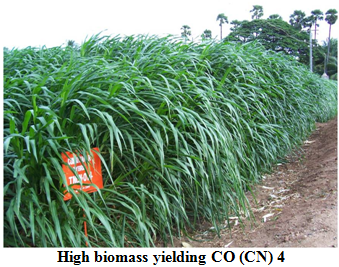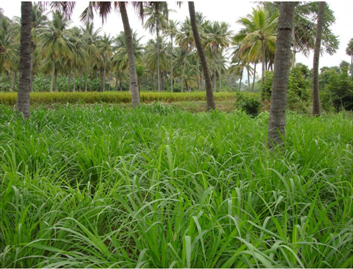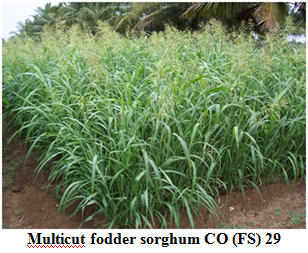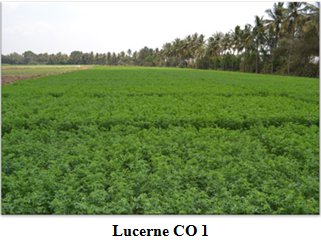Inventory of path breaking technologies, feasible at the field level
Among the forage varieties /hybrids released, Cumbu Napier hybrid CO (CN) 4, Guinea grass CO (GG) 3, Multicut fodder sorghum CO (FS) 29 and Lucerne CO 1 are very popular among the farmers of Tamil Nadu and neighboring states. These varieties have heralded a new era in fodder research and development at National level. These fodder varieties are a boon for dairy farmers across Tamil Nadu and its neighboring states of Kerala, Andhra Pradesh, Karnataka and Maharashtra. Cultivation of these varieties paved way for dairy farmers to triumph in their contribution to white revolution.
Cumbu Napier hybrid grass CO (CN) 4
Cumbu Napier Hybrid grass CO (CN) 4 is ideotypically obsessed with ideal features. The stem is ultra soft, less fibrous with sugary juice, making the fodder more palatable.
A white powdery coating on the stem is uniform and visible. The tillers are numerous and they grow faster. It has larger leaves, softer and less persistent hairs on leaf blades and sheaths and leaf edges are not very sharp.
The leaf-stem ratio is higher. As the palatability is very high, the milch animals, sheep and goats relish the fodder with least rejection.
CO (CN) 4 registered a mean green fodder yield of 382 t/ha/year which is 32.9% increased yield over the check variety CO 3 |
 |
Impact of Cumbu Napier hybrid CO (CN) 4 in India
A total quantity of 1,07,03,873 stem cuttings has been distributed across India to spread over 15 states as indicated below during the period from 2008 to 2014.
Guinea grass CO (GG) 3
The Guinea grass CO (GG) 3 is a clonal selection from Mumbasa. It has good seedling vigour with profuse tillering habit. It has larger and long leaves with high leaf stem ratio. As the palatability is very high the milch animals, sheep, goats, pigs and Emu bird relish the fodder without rejection. It had registered a mean green fodder yield of 320 tonnes per ha which was 18.5 per cent increased green fodder yield over the check variety CO 2. The dry matter yield, crude protein and crude fibre content are 79.39 t/ha/year 6.35% and 30.3%, respectively.

|

|
Multicut fodder sorghum CO (FS) 29
Sorghum, the foremost important forage crop in India followed by berseem and Lucerne is cultivated in 2.6 m ha mainly in western UP, Haryana, Punjab, Rajasthan, Tamil Nadu and Delhi and fulfills over two third of the fodder demand during Kharif season.
The popular variety Multicut fodder sorghum CO (FS) 29, first of its kind in India was released during 2001 from the Department of Forage Crops, TNAU, Coimbatore.
Being perennial, 6-7 harvests can be made in a year and can able to yield 170 t/ha/year of green fodder. It is moderately tolerant to drought. |
 |
Lucerne CO 1
It was released during 1980 from the Department of Forage Crops, TNAU, Coimbatore. It can able to yield 80-90 tonnes of green fodder in a year from a hectare.
A maximum of 12 harvests can be made in a year at an interval of 30 days. |
 |
Source:
Professor and head
Department of Forage Crops
Tamil Nadu Agricultural University
Coimbatore-641 003
Phone Number: 0422-6611228
email:
forage@tnau.ac.in
|

